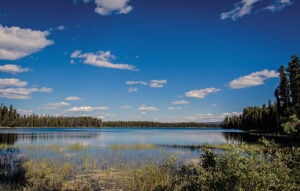Students construct a limnocorral, which was used to enclose a portion of the lake for our experiment. (Photo: Tyler Black)
Pipelines — as well as rail — are used to move this unconventional oil from upgrading facilities in northern Alberta to refineries in the United States or to coastal ports of British Columbia to be loaded into ocean tankers destined for Asian markets. There’s a great deal of pressure from the oil industry and governments to build more pipelines to move more oil out of Alberta. A number of proposed pipeline projects are on the table right now, the most high-profile of which are the Trans Mountain Expansion across British Columbia and the Keystone XL expansion through the United States.
We already know quite a bit about how oil spills behave in the ocean; scientists have, unfortunately, had the opportunity to learn from a number of accidents over the years, from the Exxon Valdez oil spill in Prince William Sound, Alaska in 1989 to the Deepwater Horizon blowout in the Gulf of Mexico in 2010. Such accidents, coupled with releases in controlled experiments, have taught us how to monitor and respond to conventional oil spills.
That’s not the case with dilbit. The body of scientific information on dilbit is pretty sparse, especially when it comes to understanding how it interacts with the countless lakes, rivers, and wetlands it encounters as it travels across North America. So sparse, in fact, that panels of experts from the Royal Society of Canada and the National Academies of Sciences, Engineering, and Medicine in the United States have both called for more research to understand what happens when dilbit spills into water bodies.
That’s where BOREAL comes in. The goal of our study is to answer important questions about the fate, behaviour, and effects of dilbit in freshwater ecosystems under various outdoor conditions, including sunlight, wind, and thunderstorms — questions that can’t be answered effectively in the laboratory.
The BOREAL experiment
Down at the shore of Lake 260, teams of students in rubber boots and work gloves get to work loading sandbags into aluminum boats. The divers head over to a large raft near the limnocorrals to set up their air support system and don their drysuits and helmets.
The operation proceeds like clockwork, with boatloads of sandbags delivered from shore to the limnocorrals for the divers to position on the flared bottom of the curtain. Over the sound of the air compressor, we can hear the divers breathing hard into the two-way radios in their helmets. After the last sandbag is placed, I jump into the water with my snorkelling gear and swim around each limnocorral, checking to ensure the installation was done properly. Satisfied with a job well done, we call it a day.
With the limnocorrals in place, the monitoring of the systems begins. Before we can manipulate them, we must first get a sense of the baseline physical, chemical, and biological characteristics of these “mini-lakes.” About three weeks later, Dr. Bruce Hollebone and his team from Environment and Climate Change Canada release precisely measured volumes of dilbit into the limnocorrals to simulate pipeline spills of different sizes. The largest amount is more than a barrel and a half, representing an oil-to-water ratio similar to that spilled in 2010 from a pipeline in the Kalamazoo River near Marshall, Michigan.







